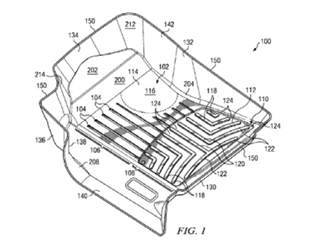Addressing the nexus between a secondary consideration and the claimed invention in assessing obviousness, the US Court of Appeals for the Federal Circuit reversed a Patent Trial & Appeal Board finding of nonobviousness because the Board erred in its nexus analysis regarding secondary considerations. Yita LLC v. MacNeil IP LLC, Case Nos. 22-1373; -1374 (Fed. Cir. June 6, 2023) (Taranto, Chen, Stoll, JJ.)
Yita petitioned for inter partes review (IPR) of all claims of two patents. The patents share a common specification and cover vehicle floor trays that are theraformed from a polymer sheet of substantially uniform thickness. These trays (illustrated below) were designed to closely conform to the walls of the vehicle foot well so that the trays would stay in place once installed.

The Board found that the claims of one of the patents were not obvious even though an artisan would have been motivated to combine the prior art asserted (which disclosed the “close conformance” limitation) and would have had a reasonable expectation of success because the evidence of secondary considerations was overpowering and included a nexus between the evidence of success and the patented invention. The Board also found that the claims of the other patent were not obvious because the “1/8 inch limitation” regarding the thickness of the foot well was not disclosed in the prior art. The Board declined to consider Yita’s argument, which was raised for the first time in its reply brief. Yita appealed.
Yita argued that the Board committed a legal error in its analysis of the secondary consideration evidence for the first patent and abused its discretion by not considering the argument Yita raised in its reply brief regarding the other patent.
On the secondary considerations issue, the Federal Circuit explained that the Board erred in finding a nexus between the secondary consideration evidence of success and the claimed invention because the Board exclusively related to a feature that was well-known in the prior art (i.e., the close conformance between the tray and the vehicle floor). The Court explained that where the prior art teaches a well-known feature and an artisan would have been motivated to combine such prior art with an expectation of success, any secondary consideration that is exclusively related to the well-known feature will not rescue the claim from obviousness. The Court noted that while secondary considerations can be linked to an individual element of the claimed invention or to an inventive combination of elements, here the Board relied on secondary consideration evidence that was related entirely to the already well-known close conformance of the tray and vehicle floor.
The Federal Circuit next addressed Yita’s argument that the Board should have considered an argument raised in Yita’s reply brief regarding the 1/8-inch limitation. Yita failed to raise the argument that it would have been obvious to modify a prior art reference to arrive at the “1/8 inch limitation” [...]
Continue Reading
read more

 Subscribe
Subscribe


